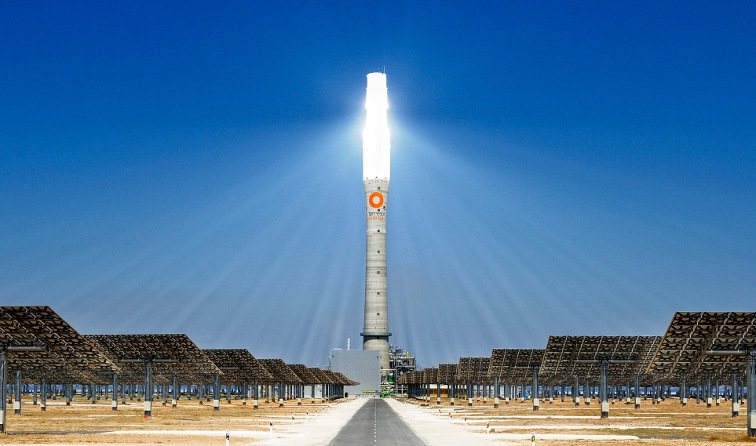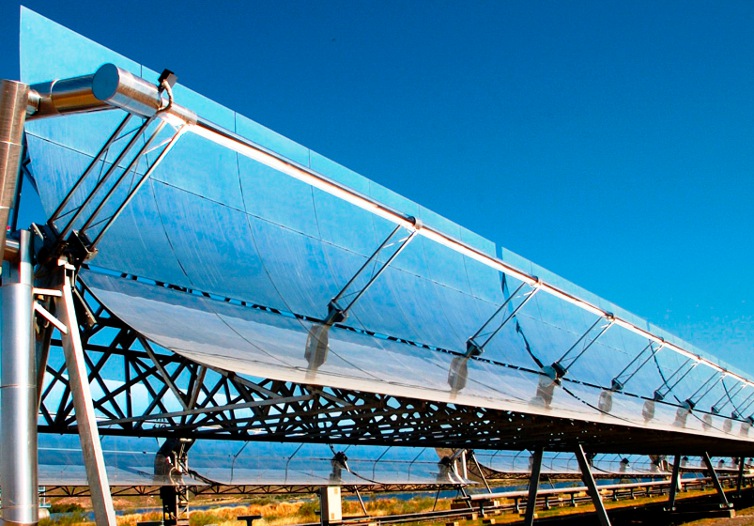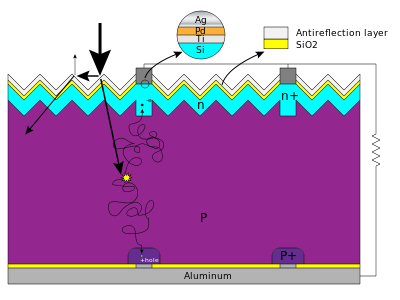Solar energy: the hope of mankind?
 They love solar energy on Habré: here Google builds solar power plants ( 1 2 3 4 5 6 ), so Germany once generated a third of the current energy consumption at solar power plants ...
They love solar energy on Habré: here Google builds solar power plants ( 1 2 3 4 5 6 ), so Germany once generated a third of the current energy consumption at solar power plants ...Comments are divided into 2 categories: "Well done, and we only burn oil" and " EROEI ! Production of solar cells requires more energy than they produce!".
A corrosive reader will surely think: How does it produce less than is required for production? They put them - they work, they do not ask for porridge, 10 years, 50 years, 100 years - it means the total energy produced is infinite, and they should be beneficial at any cost of construction ...
')
How everything is in reality, what are the approaches to solar generation, which limits the efficiency of solar cells, what brilliant ideas have already been implemented and why solar energy somehow does not actively take over the world - under the cut.
How much energy do we get from the sun?
For every square meter from the sun comes 1367 watts of energy (solar constant). It reaches the earth through the atmosphere - about 1020 watts (at the equator). If we have a solar cell efficiency of 16%, then from a square meter we can get, at best, 163.2 watts of electricity. But after all, we have the weather, the sun is not at its zenith, sometimes it is night (of different duration) - how can we calculate all this?Annual insolation takes all of this into account, including the type of solar panel installation (parallel to the ground, at the optimum angle, with tracking the sun) and lets us know how much electricity can be generated per year on average (in kWh / m 2 , excluding Efficiency of the solar battery):
| City / Installation Type | Horizontally | At optimum angle | Sun tracking |
| Astrakhan | 1371 | 1593 | 2200 |
| Vladivostok | 1289 | 1681 | 2146 |
| Moscow | 1020 | 1173 | 1514 |
| Sochi | 1365 | 1571 | 2129 |
The main approaches to obtaining energy from the sun
Solar heat-electric spaceA huge field of rotating mirrors reflects the sun to the solar collector, where heat is converted into electricity by a Stirling engine , or by heating water and then ordinary steam turbines as at a CHP plant. Efficiency - 20-30%.

There is also a variant with a linear parabolic mirror (you only need to rotate around one axis):

What is the price of the issue? If you look at the power station Ivanpah (392 MW) in which Google indirectly invested - the cost of its construction amounted to $ 2.2 billion, or $ 5,612 per kW of installed capacity. Wikipedia even happily says that, although it is more expensive than coal-fired power plants, it is supposedly cheaper than nuclear power plants.
However, there are a couple of nuances - 1kW of installed capacity at a nuclear power plant actually costs $ 2000-4000 (depending on who builds it), i.e. Ivanpah actually already turns out more expensive nuclear power plants. Then, if you look at the annual estimate of electricity generation - 1079 GWh, and divide by the number of hours per year, the average annual capacity is 123.1 MW (after all, the station at us generates only during the day).
This brings the “average” construction cost to $ 17,871 / kW, which is not just expensive, but fantastically expensive. Probably more expensive only in space to generate electricity. Conventional gas power plants cost 500-1000 $ / kW, i.e. 18-36 times cheaper , and always work, and not as lucky.
And the last thing - the cost of construction does not include batteries, in general. If you add batteries (about them below) or the construction of a pumped storage power plant - the cost will come out through the roof.
Solar thermal power plants have the ability to generate electricity around the clock, using a large amount of heat carrier heated per day. There are also such stations, but they try not to write the cost, apparently so as not to frighten anyone.
 Semiconductor photovoltaics (photovoltaics, PV) - the idea is very simple, we take a semiconductor diode of a large area. When a quantum of light flies into the pn junction, an electron-hole pair is generated that creates a voltage drop across the terminals of this diode (about 0.5V for a silicon photocell).
Semiconductor photovoltaics (photovoltaics, PV) - the idea is very simple, we take a semiconductor diode of a large area. When a quantum of light flies into the pn junction, an electron-hole pair is generated that creates a voltage drop across the terminals of this diode (about 0.5V for a silicon photocell).The efficiency of silicon solar cells is about 16%. Why so little?
The formation of an electron-hole pair requires a certain energy, no more and no less. If a quantum of light arrives with less energy than necessary, then it cannot cause the generation of a pair, and passes through silicon like glass (because silicon is transparent to infrared light further than 1.2 µm). If a quantum of light arrives with more energy than necessary (green light and shorter) - a pair is generated, but the excess energy is lost. If the energy is even higher (blue and ultraviolet light) - the quantum may simply not have time to reach the depth of the pn junction.
 In addition, light can be reflected from the surface - to avoid this, an anti-reflective coating is applied to the surface (as on the lenses in photographic lenses), and the surface can be made in the form of a comb (then after the first reflection the light will have another chance).
In addition, light can be reflected from the surface - to avoid this, an anti-reflective coating is applied to the surface (as on the lenses in photographic lenses), and the surface can be made in the form of a comb (then after the first reflection the light will have another chance).Efficiency above 16% can be increased for photocells by combining several different photoelectric cells (based on other semiconductors, and accordingly with different energy required for generating an electron-hole pair) - first we put the one that effectively absorbs blue light, and green, red and IR transmits , then green, and at the end red and IR. It is on these 3-step elements and achieved record performance indicators of 44% and above .
Unfortunately, 3-step photocells turn out to be very expensive, and now ordinary cheap single-stage silicon photocells rule the ball - it is due to a very low price that they rush forward in terms of watts / $. The cost of one watt for silicon photocells has gone down with the introduction of giant productions in China up to ~ 0.5 $ / Watt (i.e. for $ 500 you can buy solar cells for 1000 Watt).
The main types of silicon cells are monocrystalline (more expensive, slightly higher efficiency) and polycrystalline (cheaper to manufacture, literally 1% less efficiency). It is polycrystalline solar cells that now give the lowest cost per watt of generated power.
Of the problems - solar panels are not eternal. Even if you do not take into account dust and dirt (we hope for rain and wind), due to photodegradation for 20 years of operation, the best silicon cells lose ~ 15% of power. Perhaps further degradation slows down, but it still needs to be taken into account.
Now let's go through the main attempts to increase economic efficiency:
And let's take a small high-performance photocell and a parabolic mirror
This is called concentrated photovoltaics. The idea is not bad in principle - the mirror is cheaper than the solar battery, and the efficiency can be 40% and not 16 ... The only problem is that the (unreliable) mechanics for tracking the sun are now needed, and our huge swivel plate should be strong enough to resist gusts of wind. Another problem - when the sun sets behind not too dense clouds - energy production drops to zero, because A parabolic mirror cannot focus the diffused light (for ordinary solar cells, the output certainly drops, but not to 0).
With the fall in prices for silicon solar cells, this approach was too expensive (both in terms of installation cost and maintenance)
And let's make the solar cells round, place them on the roof, and paint the roof white
This was done by the now notorious Solyndra company, which, with the filing of Barack Obama, received a state guarantee on a loan of $ 535 million from the US Department of Energy ... and suddenly declared bankruptcy. Round solar cells were made by spraying a layer of semiconductor (in their case, Copper indium gallium (di) selenide) on glass tubes. The efficiency of solar cells was 8.5% (yes, it turned out worse than simple and cheap silicon).
A vivid example of how American capitalism, with proper lobbying, is capable of inertia pumping huge resources into fundamentally inefficient technologies. According to the results no one was planted.
Road spoon for dinner
Now, after this riot of continuous improvement of technology, we open a sad page of history. Solar power plants generate electricity during the day, and it is most needed in the evening:
This means that if we do not have batteries, power plants will have to be built at the evening peak of consumption, and during the day, some of them should be turned off, and some should be in a hot reserve so that if clouds gather over the solar power plant, they will immediately replace the solar generation.
It turns out, if we oblige to buy electricity from solar power plants at the usual price when it is generated from them - we actually redistribute profits from the existing classical generating capacities, which are forced to stand idle in the afternoon in favor of solar ones.
There is such an interesting option - if somewhere in the evening peak of consumption - somewhere on earth is the height of the day. Can build a solar power plant there, and transfer electricity through power lines? This is possible, but it requires energy transfer over distances of about 5-8 thousand km, which also requires huge capital expenditures (at least until we switched to superconductors) and coordination with a bunch of countries. Approximately in this direction the project Desertec was developing - generation in Africa, transfer to Europe.
Batteries
So, 1W solar battery costs $ 0.5. In a day it will generate, say, 8W * h of electricity (in 8 hours of sunshine). How do we save this energy until the evening, when it will be most needed?Chinese lithium batteries cost about $ 0.4 per Wh, respectively, for 1W of solar battery (at a cost of $ 0.5) we need batteries for $ 3.2, i.e. The battery is 6 times more expensive than the solar battery! In addition, you need to take into account that after 1000-2000 charge-discharge cycles, the battery will have to be replaced, and this is only 3-6 years of service. Can eat batteries cheaper?
The cheapest are lead-acid (which are naturally far from “green”), their wholesale price is $ 0.08 per Wh, respectively, we need $ 0.64 to save the daily output, which is again more than the cost of the solar cells themselves. Lead batteries also die quickly, 3-6 years of service in this mode. Well, for dessert - the efficiency of lead batteries - 75% (ie, a quarter of the energy is lost in the charge-discharge cycle).
There is also an option with pumped storage power plants (in the daytime - we pump water upward with a pump, at night - we work like a conventional hydroelectric power plant) - but their construction is also expensive, and not everywhere possible (efficiency - up to 90%).
Due to the fact that the batteries are more expensive than the solar power plant itself, in large power plants they are not provided for, selling electricity to the distribution network immediately as they are generated, counting at night and in the evening to conventional power plants.
What is the fair price of unregulated solar generation?
Take, for example, Germany, as a leader in the development of solar energy. Every kW generated by solar power plants there is bought at 12.08-17.45 euro cents per kWh, regardless of what they generate in the daily minimum consumption. All that they are trying to achieve with this is saving Russian gas, since gas power plants should still be built and be in hot reserve (and all their other expenses remain unchanged - salaries, loans, services).From an economic point of view, it would be fair if solar power plants received exactly as much as they allow to save on gas power plants.
Suppose the cost of Russian gas is $ 450 per 1 thousand m 3 . Of this amount, 39,000 GJ ≈10.8 * 0.4 GWh ≈ 4.32 GWh of electricity can be generated (with a generation efficiency of 40%), respectively, for 1 kWh of solar electricity, we save Russian gas by $ 0.104 = 7.87 eurocents. This is exactly what the fair value of unregulated solar generation should be, and it looks like Germany is gradually moving towards this figure, but at the moment solar energy in Germany is 50% subsidized.
Summary
Polycrystalline solar cells provide the cheapest solar electricity, about 0.5 $ / Watt, other methods are much more expensive.The problem of solar energy is not in the efficiency of solar cells, not in EROEI (it’s really infinite in theory), and not in their price - but in the fact that the generated energy is very expensive to store until evening. Those. The main problem is batteries, which are now more expensive than solar batteries and at the same time have a short service life (3-6 years).
At the moment, large-scale solar generation without batteries can only be seen as a way to save a small part of fossil fuel during the day, it cannot fundamentally reduce the number of required classical power plants (gas, coal, nuclear power plants, hydro) - they should still be in reserve during the day, and completely take on the load in the evening peak of consumption.
If in the future it will be possible to shift the peak of consumption by day with the help of (cruel) tariffs - the construction of solar power plants will acquire more meaning (for example, if the tariffs are such that it would be beneficial to include electrolysis production of aluminum and hydrogen only during the day).
The cost of "unregulated" solar generation cannot be compared with the cost of generation at classical power plants - because they generate when it works, not when needed. The fair value of unregulated solar electricity should be equal to the cost of saved fossil fuels, and no more - for gas at $ 450, the fair price of solar generation is no higher than $ 0.1 per 1 kWh (accordingly, in Germany solar generation is subsidized by ~ 50%).
“Honest” solar energy (with batteries) today can be economically justified only in remote areas where it is not possible to connect to the network (as for example in the case of a remote, stand-alone cellular base station).
The biggest problem of solar energy - fossil fuels are still too cheap for solar generation to be economically viable.
Update: For further study, we can recommend an article on the problems of Germany’s energy in connection with solar and wind generation . There are beautiful production schedules, and in general I recommend reading Already_Yet other articles.
Source: https://habr.com/ru/post/158875/
All Articles